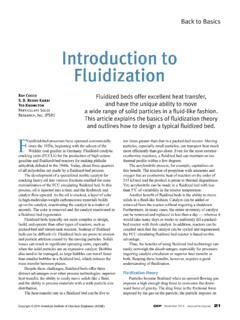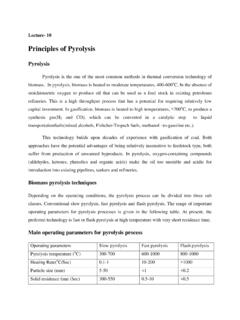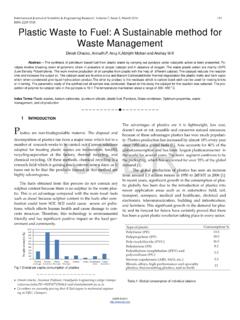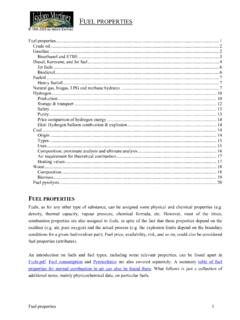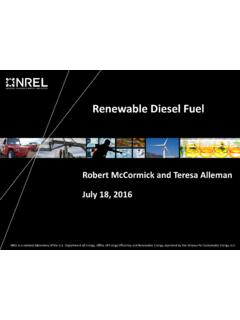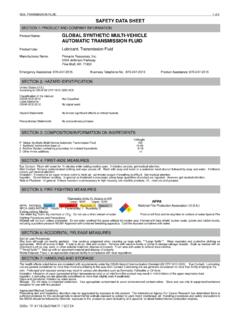Transcription of Section 168.-- Accelerated Cost Recovery System (Also ...
1 Section Accelerated Cost Recovery System 26 CFR (a)-1: Modified Accelerated cost Recovery System . (Also 167, (a)-11) Rev. Rul. 2014-17 ISSUE What is the proper asset class under Rev. Proc. 87-56, 1987-2 674, as clarified and modified by Rev. Proc. 88-22, 1988-1 785, for the depreciation of tangible assets that are used in converting corn to fuel grade ethanol? FACTS Taxpayer owns a facility operated primarily to produce fuel grade ethanol. Fuel grade ethanol is a colorless, flammable liquid that is an organic chemical, and a high octane alternative fuel source. Taxpayer produces fuel grade ethanol from corn. Taxpayer grinds the corn into flour, mixes the resulting corn flour with water, increases the temperature, and adds enzymes to convert the starch in the solution to simple sugars. Taxpayer feeds the resulting mash (water, sugars, and non-convertible solids) into fermentation tanks where yeast is added.
2 Over a period of several days the yeast metabolizes the sugars into ethanol and carbon dioxide (CO2). The CO2 produced during fermentation may be collected, compressed, and sold as a by-product. 2 Taxpayer then sends the ethanol solution to distillation columns to separate the ethanol from the solids and water. After distillation, taxpayer produces fuel grade ethanol by further processing part of the output using dehydration to increase alcohol content. Dehydration is accomplished by using molecular sieves that separate the remaining water molecules from the ethanol. Once the dehydration is complete, Taxpayer blends the fuel grade ethanol with 2 to 5 percent denaturant (such as natural gasoline or unleaded gasoline ) and sends it to storage pending sale. Taxpayer also processes the solids and other liquids derived from the distillation to produce distillers grains, an animal feed supplement, which it sells.
3 More than 50 percent of the economic output at Taxpayer s facility is from fuel grade ethanol production. LAW Statutory Scheme Section 167(a) of the Internal Revenue Code provides that there shall be allowed as a depreciation deduction a reasonable allowance for the exhaustion and wear and tear of property used in a trade or business or held for the production of income. The depreciation deduction provided by 167(a) for tangible property placed in service after 1986 generally is determined under 168, which prescribes two methods of accounting for determining depreciation allowances: (1) the general depreciation System in 168(a); and (2) the alternative depreciation System in 168(g). Under either depreciation System , the depreciation deduction is computed by using a prescribed depreciation method, Recovery period, and convention. This revenue ruling addresses the applicable Recovery period.
4 3 The applicable Recovery period for purposes of either 168(a) or 168(g) is determined by reference to class life or by statute. Section 168(i)(1) provides that the term class life means the class life (if any) that would apply to any property as of January 1, 1986, under former 167(m) as if it were in effect and the taxpayer had made an election under that Section . Prior to its revocation, 167(m) provided that, if a taxpayer elected the asset depreciation range System of depreciation, the depreciation deduction would be computed based on the class life prescribed by the Secretary that reasonably reflected the anticipated useful life of that class of property to the industry or other group. Rev. Proc. 87-56 sets forth the class lives of property in effect as of January 1, 1986, that are necessary to compute depreciation under 168. Primary Use Test Section (a)-11(b)(4)(iii)(b) of the Income Tax Regulations provides rules for classifying property under former 167(m) and, under these rules, property is included in the asset class for the activity for which the property is primarily used (the primary use test).
5 Property is classified according to its primary use even though the activity for which the property is primarily used is insubstantial in relation to all the activities of the taxpayer. Courts have considered the primary use standard for asset classification under (a)-11(b)(4)(iii)(b). See, , Clajon Gas Co, v. Commissioner, 354 786 (8th Cir. 2004). In applying the primary use test, courts have clarified that the actual purpose and function of an asset determines its asset class (a use-driven functional standard) rather than the terminology used to describe an asset. Asset Classes 4 Rev. Proc. 87-56 sets forth the class lives of property that are necessary to compute the depreciation allowance under 168. This revenue procedure establishes two broad categories of depreciable assets: (1) asset classes through , which consist of specific assets used in all business activities (asset categories); and (2) asset classes through , which consist of assets used in specific business activities (activity categories).
6 The same item of depreciable property may fall within both an asset category and an activity category, in which case the item is generally classified in the asset category. See Norwest Corporation & Subsidiaries v. Commissioner, 111 105, 162 (1998). Asset class of Rev. Proc. 87-56, Waste Reduction and Resource Recovery Plants, includes assets used in the conversion of refuse or other solid waste or biomass to heat or to a solid, liquid, or gaseous fuel. This asset class also includes all process plant equipment and structures at the site used to (1) receive, handle, collect, and process refuse or other solid waste or biomass to a solid, liquid, or gaseous fuel, or (2) handle and burn refuse or other solid waste or biomass in a waterwall combustion System , oil or gas pyrolysis System , or refuse derived fuel System to create hot water, gas, steam, or electricity. Asset class also includes material Recovery and support assets used in refuse or solid refuse or solid waste receiving, collecting, handling, sorting, shredding, classifying, and separation systems.
7 Asset class does not include any package boilers, or electric generators and related assets such as electricity, hot water, steam, and manufactured gas production plants classified in classes , , , and of Rev. Proc. 87-56. Asset class includes, however, all other utilities such as water supply and treatment facilities, ash handling, 5and other related land improvements of a waste reduction and resource Recovery plant. Assets in class have a Recovery period of 7 years for purposes of 168(a) and 10 years for purposes of 168(g). Asset class of Rev. Proc. 87-56, Manufacture of Chemicals and Allied Products, includes assets used to manufacture basic organic and inorganic chemicals; chemical products to be used in further manufacture, such as synthetic fibers and plastics materials; and finished chemical products. This asset class also includes, among other things, all land improvements associated with plant site or production processes, such as effluent ponds and canals, provided such land improvements are depreciable but does not include buildings and structural components as defined in (e).
8 Asset class does not include assets used in the manufacture of finished rubber and plastic products or in the production of natural gas products, butane, propane, and by-products of natural gas production plants. Assets in class have a Recovery period of 5 years for purposes of 168(a) and years for purposes of 168(g). Rev. Rul. 77-63, 1977-1 60, establishes that the mere use of a chemical process in the production of a product does not require an activity to be classified in asset class That revenue ruling addresses the question of whether assets used to produce alumina are classified in asset class , Manufacture of Primary Nonferrous Metals, despite the fact that production used chemical processes. The chemical processes were part of the taxpayer s overall process of producing semi-finished and finished aluminum products from bauxite ore that the taxpayer mined. Asset class includes assets used in the smelting, refining, and electrolysis of nonferrous metals from 6ore.
9 Rev. Rul. 77-63 concludes that the chemical processes used to produce the alumina were an integral part of refining of the nonferrous metal and further concludes that all of the assets used in the processing of the bauxite ore into primary aluminum (basic metal), including those used in the chemical processes to produce alumina, are classified in asset class However, the revenue ruling provides that assets used to process the alumina for use in activities other than those required to produce the basic metal should be classified in other asset classes. ANALYSIS Asset class of Rev. Proc. 87-56 specifically applies to assets used in the conversion of biomass to a liquid fuel. Under energy credit provisions that were enacted near the same time asset class was first established in 1979 by Rev. Proc. 79-26, 1979-1 566, biomass means any organic substance other than oil, natural gas, coal, or product of oil or natural gas or coal.
10 See 48(l)(15)(B)(i), (l)(3)(B) as in effect on the day before the date of enactment [11/5/90] of the Revenue Reconciliation Act of 1990, Pub. L. The depreciation and the former energy credit provisions of Section 48(l) are both based on cost Recovery concepts. Although 48B(c)(4)(A) also includes a definition of biomass, that provision was enacted significantly later as part of the Energy Tax Incentives Act of 2005 (Pub. L. 109-58) and is specific to the production of synthesis gas. Accordingly, the definition of biomass in former 48(l) is a more appropriate definition of biomass for purposes of asset class 1 In defining biomass property, former 48(l)(15), which was added to the Code in 1980, used (with some modifications) the definition of the term alternate substance in former 48(l)(3), which was added to the Code in 1978. 7 The corn used in Taxpayer s facility is biomass, that is, an organic substance other than oil, natural gas, coal, or a product thereof.











